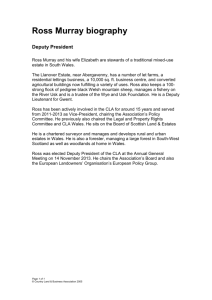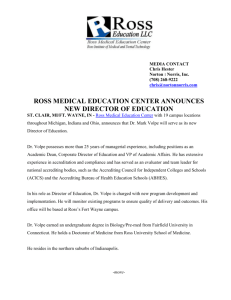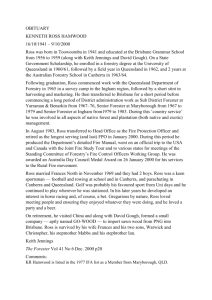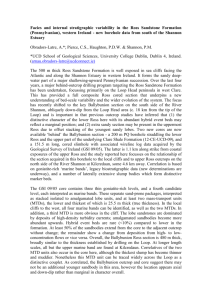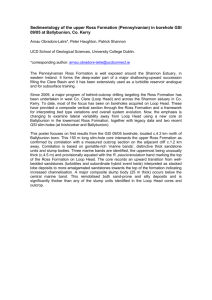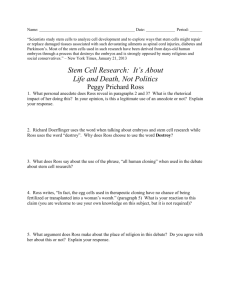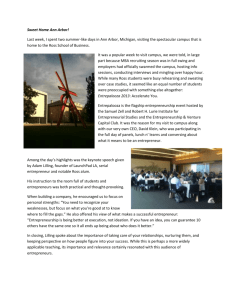Here - Regional Open Space Strategy (ROSS)
advertisement
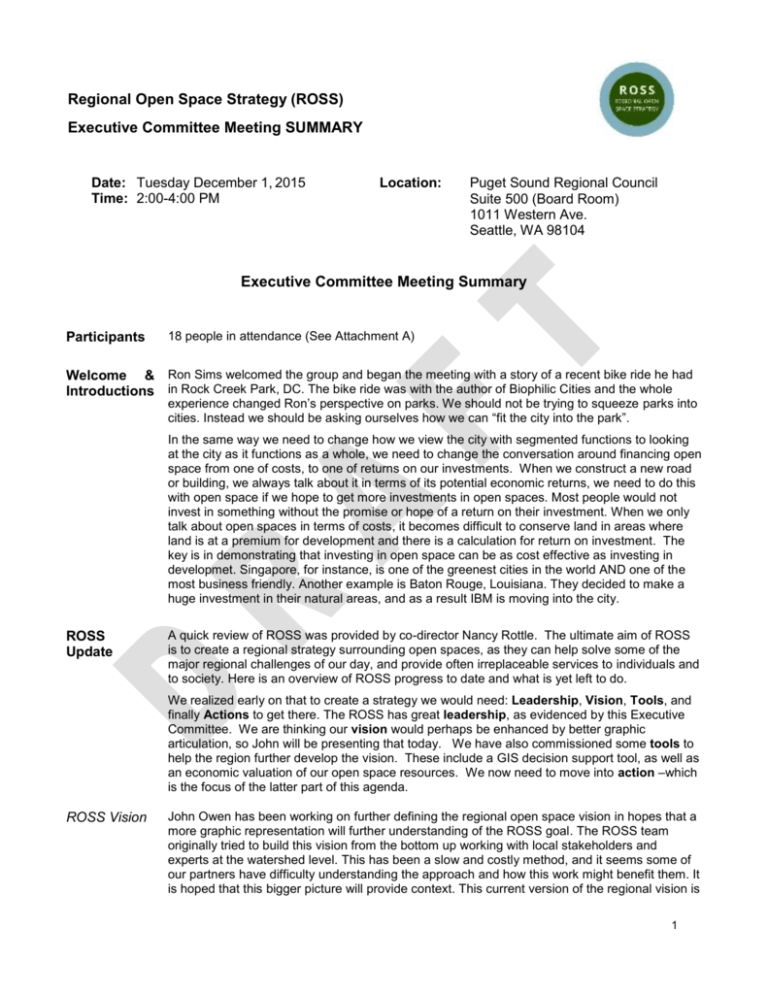
Regional Open Space Strategy (ROSS) Executive Committee Meeting SUMMARY Date: Tuesday December 1, 2015 Time: 2:00-4:00 PM Location: Puget Sound Regional Council Suite 500 (Board Room) 1011 Western Ave. Seattle, WA 98104 Executive Committee Meeting Summary Participants 18 people in attendance (See Attachment A) Welcome & Ron Sims welcomed the group and began the meeting with a story of a recent bike ride he had Introductions in Rock Creek Park, DC. The bike ride was with the author of Biophilic Cities and the whole experience changed Ron’s perspective on parks. We should not be trying to squeeze parks into cities. Instead we should be asking ourselves how we can “fit the city into the park”. In the same way we need to change how we view the city with segmented functions to looking at the city as it functions as a whole, we need to change the conversation around financing open space from one of costs, to one of returns on our investments. When we construct a new road or building, we always talk about it in terms of its potential economic returns, we need to do this with open space if we hope to get more investments in open spaces. Most people would not invest in something without the promise or hope of a return on their investment. When we only talk about open spaces in terms of costs, it becomes difficult to conserve land in areas where land is at a premium for development and there is a calculation for return on investment. The key is in demonstrating that investing in open space can be as cost effective as investing in developmet. Singapore, for instance, is one of the greenest cities in the world AND one of the most business friendly. Another example is Baton Rouge, Louisiana. They decided to make a huge investment in their natural areas, and as a result IBM is moving into the city. ROSS Update A quick review of ROSS was provided by co-director Nancy Rottle. The ultimate aim of ROSS is to create a regional strategy surrounding open spaces, as they can help solve some of the major regional challenges of our day, and provide often irreplaceable services to individuals and to society. Here is an overview of ROSS progress to date and what is yet left to do. We realized early on that to create a strategy we would need: Leadership, Vision, Tools, and finally Actions to get there. The ROSS has great leadership, as evidenced by this Executive Committee. We are thinking our vision would perhaps be enhanced by better graphic articulation, so John will be presenting that today. We have also commissioned some tools to help the region further develop the vision. These include a GIS decision support tool, as well as an economic valuation of our open space resources. We now need to move into action –which is the focus of the latter part of this agenda. ROSS Vision John Owen has been working on further defining the regional open space vision in hopes that a more graphic representation will further understanding of the ROSS goal. The ROSS team originally tried to build this vision from the bottom up working with local stakeholders and experts at the watershed level. This has been a slow and costly method, and it seems some of our partners have difficulty understanding the approach and how this work might benefit them. It is hoped that this bigger picture will provide context. This current version of the regional vision is 1 a sketch of what the ROSS team thinks they know about the most pressing issues to be addressed – garnered from the previous discussions with local experts. The plan is now to bring this mock up back to the local experts to be changed, molded, etc. as appropriate. The ultimate goal of this vision is to hopefully create a collective vision that elevates activities already under way in the region. It is hoped that with this physical or spatial vision, it will be easier to move into the regional governance and finance discussions. The current sketch of the vision considers possible trail connections, aquatic system activities, priority habitats for biodiversity, forest lands, agricultural lands, and active living activities as they relate to human health, equity and community development. When you combine all of these action/priority layers you get some concentration of different elements, hot spots that warrant real focus. This shows that there may be some ways to geographically link actions, similar to the mountains to sound greenway. This graphic is only a first step to help identify strategies and better communicate them in a compelling way. Discussion: Ken Konigsmark – We just had a climate summit in Paris, we need to do something similar in the four country region here to inspire action. We need the leaders, corporations, real estate, residents, and non-profits to buy into open space conservation before it can happen, and this will take a lot of work. o Nancy – are you suggesting a summit? o Ken – yes, and invite the press. This would be a good tool to get that buy in from the required senior level. o Ron – If you have a summit, you have to be sure key people are in the room to ensure balanced discussion and outcomes. We need to be sure to include the business community. Businesses needs to know that they have a stake in the game and ensure that it’s not just another government plan. John – the notion of reaching out to the business community is important. And we’ve had pretty good success so far. We met with representatives from Boeing – they are willing to be engaged if we can help them with a regional stormwater effort. Ken – Sally Jewell would be another great facilitator. David Batker – we need to integrate this vision within local, state, and federal plans. There is a big opportunity to save through increased efficiencies if we coordinate efforts in general. o Nancy – do you have ideas on how to integrate? o David – in Louisiana they are trying to integrate open space planning into the economic plans of each parish. o Nancy – could there be requirements in the GMA that says comprehensive plans must recognize regional open space goals? Could this be possible through PSRC? Erika Harris – I’m not sure about the GMA, but we are looking at updating Vision 2040. The ROSS vision could be a great tool in that process. ROSS has some great information to pull into the research and discussion around updating Vision 2040. Although, the policy board makes the final decision, so we really need to get them engaged. Paul Ingraham– it’s an interesting idea thinking about what GMA could require. It doesn’t require open space planning at the local level right now, although it does include critical areas planning and coordination with other jurisdictions. This idea is definitely something to put in the parking lot of ideas. Again really need to get leadership on board. When the GMA was first being adopted, all the local and policy leaders got together to help decide where growth should go. We could use John’s tool to do the same thing for open spaces and conservation activities. 2 And have the policy leaders themselves tell us where the priority areas are located. Zach Christin –I would suggest grabbing on to good case studies and identify stakeholders to highlight. Like John did with the vision, highlight the hotspots. Make it easier to prioritize projects based on return on investment. Finding the hot spots and the stakeholders within them would be a key piece. Ken – I don’t know the status on region-wide transportation planning from PSRC, although I think more effort has gone into that than open space planning. Can we use this work with transportation as a lessons-learned for open space planning? How did you get the four counties to work together there? o Ron – The four counties are required by the government to do that. The difference in this region, versus others in the nation, is that the PSRC is willing to address other issues beyond just transportation. The major issue though is funding. o Nancy – Yes, it is in PSRC’s purview to work on open space planning, but there is no funding. ROSS Tools TPL Open Space Valuation Portal Nancy briefly discussed one of the major tools ROSS has been working on with Trust for Public Land (TPL). Currently constructing an open space service valuation tool that would be available online. A decision maker using the tool should be able to plug in a proposed project and see what the open space services of that project could be if it was completed. Tracy Stanton is leading this effort, and noted that real benefit of the tool is that you can layer ecological benefits, that are really hard to quantify, on top of one another. We could combine this with John’s vision to help identify the hot spots, and then tease out the prioritized areas to see where our investments in a certain landscape would yield the largest benefits for the most people. Central Puget Sound Open Space Valuation Another ROSS tool is the work conducted by Earth Economics to assess the value of open spaces in the region. As presented at the last meeting, ten open space services contribute $25.2 billion a year to the regional economy (not even including farm or forest products and several other services.) Regional Finance & Governance Nancy summarized that we have leadership, vision, tools, and now we need to integrate these into actions that enhance our collective impact. Through a focus on regional finance and governance it is hoped the ROSS can move toward that action. David Batker gave a presentation on the work Earth Economics has been doing to help change the conversation about open spaces. How we can fit cities into parks by focusing on the return on investment. We traditionally have not thought about natural resources as an economic benefit, although there are lots of changes afoot in federal agencies such as HUD. HUD wanted to change the economics of how cities and states do the funding. For instance, in Alaska open spaces provide a flood risk reduction. And if you can show the money that you saved by preventing a flood from washing out infrastructure, that’s an important argument. o Built structures have value. They are all taxed and assessed. Yet green spaces do not. If you upgrade these spaces, increase habitat or flood risk reduction, then you get an increase in return. But if you don’t have a baseline, how can you calculate the added benefit? Louisiana has lost 1.9 million acres of land (wetlands) and this brings severe storms in closer proximity to the urban areas. Because of the risks posed by storm surges, 2.2 million people will have to move away if action is not taken. 3 o Louisiana decided they needed to invest $50 billion in coastal areas by diverting sediment from the Mississippi to rebuild wetlands instead of allowing the sediment to flow off the shelf. Their actions could create a 4 to 1 return on investment if just one storm’s impact is reduced. We need to realize the scale and importance of open space. o We haven’t had a tremendous collapse of our systems in the Puget Sound like they had in Louisiana, but we will have a tremendous amount of people moving here, and if we want to have a successful economy, we will need to plan. o Let’s take natural systems seriously and investment in natural systems seriously. What is our scale? o There are micro-questions such as: What is your rate of return on a single investment? Do you put in a road here? Do you invest in this conservation easement? o The scalable question is how much funding is needed for the region? Hundreds of billions of dollars, and it is tied to real wages. The scale question relates to institutions. o Our green and grey infrastructures need to fit together. We can have a levee, but if don’t have wetlands attached to it, you will need the levee to be bigger. o What does a rate of return on investment for open space mean? Somethings, like quality of life are not quantifiable. One thing we can quantify is the urban heat island effect. Ron – we don’t do rates of returns with green spaces. If we had this tool, then we could show the returns on investments. There will be people willing to compromise nature if they don’t know what the true costs are of losing the capacity of green infrastructure to provide the services we take for granted; i.e., water supply, stormwater retention, flood & storm surge protection, clean air, ag/forest products, etc. If we decide about the scale, then we need to decide about government framework, investments, governance, etc. Sonoma and Santa Clara have open space districts with taxing powers. They approved a $150 million bond (supported by the business community because of the straight forward economic argument). We need the water authority to be paying for recharge of groundwater. Each open space service can have a funding mechanism attached to it. Another case – coastal restoration authority in Louisiana allocating their $50 billion to build diversions to keep sediment from falling off the shelf. We need funding institutions and mechanisms. These could be major focus topics for discussion at a summit for the Puget Sound region. Discussion: Jessie Israel – what would this type of tool cost? o David – for rate of return it’s complicated because of regional and the values considered for each service. Nancy – the scale of an analysis takes a long time. How can we make it feasible for every agency to do that type of analysis? Earth Economics may not have the capacity. o David – ecosystem value tool is scalable so they can conduct studies much faster. We don’t have a full tool yet, just a full set of excel tables working together. Tracy – can there be lessons learned from Louisiana and the $50 billion fund? How much was new money and how much was pulled from existing institutions? o David – they don’t have $50 billion in the door yet. A big portion of the dollar amount so far has come from the BP spill compensations. Still looking for more. There is a charge for dredging – if they created a fee for cargo they could raise $450 million a year. That’s the right scale because looking at $50 billion over 40 years or so. If you solve the question about scale then it guides you through other questions like governance and funding mechanisms. 4 Meeting Close Ron asked that Earth Economics do study on return on investment, prior to gathering people for a meeting on governance. It would be helpful if we could have that before the meeting, it will be easier to go to different communities and entice them to participate. Ron suggests that staff consider putting together a summit to focus on ROI & governance in 2016. In the meantime, be thinking of how dollars-and-cents knowledge about a return on an open space investment might be useful to you. 5
